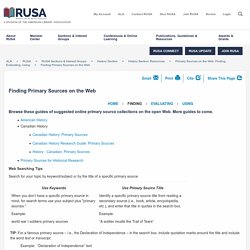

Kiddle - visual search engine for kids. Making Sense of Evidence. Making Sense of Evidence This section helps students and teachers make effective use of primary sources.

“Making Sense of Documents” provide strategies for analyzing online primary materials, with interactive exercises and a guide to traditional and online sources. “Scholars in Action” segments show how scholars puzzle out the meaning of different kinds of primary sources, allowing you to try to make sense of a document yourself then providing audio clips in which leading scholars interpret the document and discuss strategies for overall analysis. Making Sense of Documents Making Sense of Oral HistoryWritten by Linda Shopes, this guide presents an overview of oral history and ways historians use it, tips on what questions to ask when reading or... Library of Congress. Reference & User Services Association (RUSA)
Browse these guides of suggested online primary source collections on the open Web.

More guides to come. Web Searching Tips Search for your topic by keyword/subject or by the title of a specific primary source TIP: For a famous primary source – i.e., the Declaration of Independence – in the search box, include quotation marks around the title and include the word text or transcript. Example: “Declaration of Independence” text Finding Images on the Web Back to top of page An Internet search on just about any topic will bring up hundreds or thousands of images, but the challenge is finding one from a reputable source that you can use and cite confidently in an assignment or paper.
Using Images Ethically Consider copyright: Using images for academic assignments is usually considered “fair use”. Give credit: Be sure to give credit by including as much information about the image as you can find: title, photographer or artist, date of creation, collection name (if applicable), etc. Libraries. Guidelines for Behavioral Performance of Reference and Information Services Professionals. Revised by MOUSS Management of Reference Committee and approved by the RUSA Board of Directors, June 2004.

(Listing of members and authors.) Introduction The face of Reference Services has changed significantly since the original RUSA Guidelines for Behavioral Performance were first published in 19961. Intended to be used in the training, development, and/or evaluation of library professionals and staff, the Guidelines have subsequently been favorably evaluated by the profession, and currently enjoy widespread acceptance as standards for the measurement of effective reference transactions.2. How to Make a Time Capsule. Watch this instructional video to find out how you can make your own time capsule out of business reply envelopes (4.12 x 9.5’’) and other household supplies.

Bel Mills, a collage artist and book designer, demonstrates the simple steps to create your own journal for posterity...or your future self, at least. Need ideas of what to put into your journal once it's completed? Check out an inspiration video to guide you through some common items to save in your finished product. Supplies: 6 Business Reply Envelopes Ruler Fine Tip Marker Embroidery Thread Needle Button Glue Stick Washi Tape File Label Stickers Scissors Watch this instructional video for step-by-step directions on how to make a time capsule: Search engines. Save The Pacific Northwest Tree Octopus.
Help Save The ENDANGERED From EXTINCTION!

C.R.A.P. Test - Evaluating Sources - Libraries at Houston Community College. The C.R.A.P.

Test* is a way to evaluate sources in four main categories: Currency Is the resource from an appropriate time? • When was it originally published? • Has it been updated or revised since then? Reliability Can you depend on the information and trust it to be accurate? • Did the author use any evidence, and show their sources with citations and references, or list of sources? Authority Can you trust the source the information comes from? • Who is the author, and what are their credentials? Purpose/Point of View What is the author's motivation for publishing the resource? • Is the author trying to inform, persuade, sell to, or entertain you? * The C.R.A.P. Tame the Chaos of Classroom Research (IIM update 2015-ALT vers.) IIM research skills. IIM Research. IIM Parent Presentation GTA 2018.